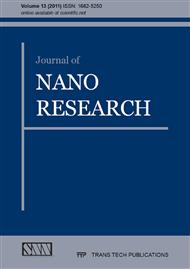[1]
A. Petrella, M. Tamborra, P.D. Cozzoli, M.L. Curri, M. Striccoli, P. Cosma, G.M. Farinola, F. Babudri, F. Naso, and A. Agostiano, TiO2 nanocrystals - MEH-PPV composite thin films as photoactive material, Thin Solid Films 451-452 (2004), 64-68.
DOI: 10.1016/j.tsf.2003.10.106
Google Scholar
[2]
C. Kwong, W. Choy, A. Djuriši , P. Chui, K. Cheng, and W. Chan, Poly (3-hexylthiophene): TiO2 nanocomposites for solar cell applications, Nanotechnology 15 (2004), 1156-1161.
DOI: 10.1088/0957-4484/15/9/008
Google Scholar
[3]
T. Zeng, Y. Lin, H. Lo, C. Chen, C. Chen, S. Liou, H. Huang, and W. Su, A large interconnecting network within hybrid MEH-PPV/TiO2 nanorod photovoltaic devices, Nanotechnology 17 (2006), 5387-5392.
DOI: 10.1088/0957-4484/17/21/017
Google Scholar
[4]
A. Ltaief, J. Davenas, A. Bouazizi, R. Ben Chaâbane, P. Alcouffe, and H. Ben Ouada, Film morphology effects on the electrical and optical properties of bulk heterojunction organic solar cells based on MEH-PPV/C60 composite, Materials Science and Engineering: C 25 (2005).
DOI: 10.1016/j.msec.2004.09.003
Google Scholar
[5]
G. Kickelbick, Concepts for the incorporation of inorganic building blocks into organic polymers on a nanoscale, Progress in Polymer Science 28 (2003), 83-114.
DOI: 10.1016/s0079-6700(02)00019-9
Google Scholar
[6]
H. Neugebauer, C. Brabec, J.C. Hummelen, and N.S. Sariciftci, Stability and photodegradation mechanisms of conjugated polymer/fullerene plastic solar cells, Solar Energy Materials & Solar Cells 61 (2000), 35-42.
DOI: 10.1016/s0927-0248(99)00094-x
Google Scholar
[7]
A.J. Breeze, Z. Schlesinger, S.A. Carter, and P.J. Brock, Charge transport in TiO2/MEH-PPV polymer photovoltaics, Physical Review B 64 (2001), 125205-125214.
Google Scholar
[8]
K. Inpor, S. Reabanko, P. Boonchan, N. Mahingsupan, S. Sahasithiwat, P. Limthongkul, C. Sae-Kung, P. Sichanugrist, and C. Thanachayanont, An effect of TiO2 morphology on performance of ITO/TiO2/MEH-PPV/Au solar cells, IEEE journal (2008), 829-832.
DOI: 10.1109/ecticon.2008.4600558
Google Scholar
[9]
L. Chi, N. Dinh, P. Long, D. Chien, and T. Thuy, Study on Electrical and Optical Properties of the Hybrid Nanocrystalline TiO2 and Conjugated Polymer Thin Films, Nano-Net 20 (2009), 84-89.
DOI: 10.1007/978-3-642-04850-0_13
Google Scholar
[10]
B.L. Anderson and R.L. Anderson, Fundamentals of Semiconductor Devices. Singapore: McGraw Hill, (2005).
Google Scholar
[11]
N. Dinh, L. Chi, N. Long, T. Thuy, T. Trung, and H. Kim, Preparation and characterization of nanostructured composite films for organic light emitting diodes, Journal of Physics: Conference Series 187 (2009), pp.012029-12036.
DOI: 10.1088/1742-6596/187/1/012029
Google Scholar


